Monthly Archives: March 2016
FRANKENSTEIN DA GAMBA?
Sitting next to its very formal neighbour, the Forster viola, in Old Tullie House, the viol da gamba looks downright relaxed. His ample frontage, deep ribs, sagging shoulders “rustic” construction and finish suggest an old chap in retirement. But who would have thought that an old chap like that would have had cosmetic surgery – or even something rather more severe – like a complete new head? This old chap is not entirely what he appears to be.
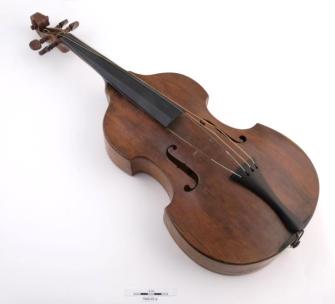
The Tullie’s viol da gamba-cum-viola
Of all the bowed instruments, the viol da gamba stands out; but not because it’s beautiful like the viola d’amore or the Amati violin. The viol is not a pretty instrument; it is best to say that it looks “country-made” and it looks downright wrong because the neck, head, scroll, and tailpiece, are not the ones it was born with. This is an 18th century instrument made into something more modern. So how? And, equally interestingly, why?
Brampton violin-maker Corrie Schrijver was a great help in deciding whether the instruments in Old Tullie House were in a condition that would allow their exhibition. They have been out of sight for all but a very brief time for at least 20 years; hers was the first expert eye on them for rather longer than that.
Corrie said it was plain the VDG’s neck has been re-shaped, that the surgery really had been very drastic and done entirely to turn an instrument that once had ten strings into one that has just four – an imposing, if peculiar, viola.
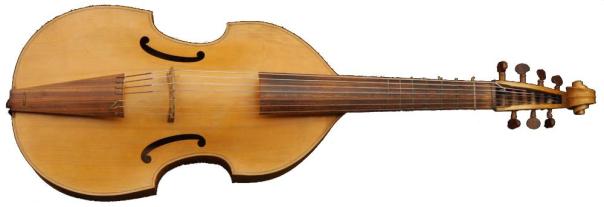
A modern viol da gamba with seven strings
And yes, ten strings. Corrie pointed out the ten filled holes in the bottom of the viol and the long ebony saddle across the bottom, under the gut loop holding the new tailpiece. It was common for viols to have six strings, seven too, some eight. Is ten too many for a VDG?
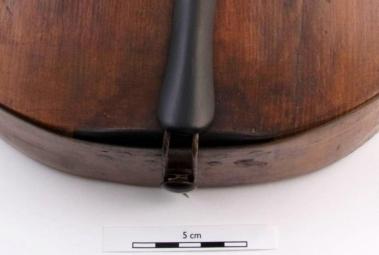
Figure1 – Ten filled holes say this instrument once had ten strings
Corrie wondered even if it was originally a “country-made” – aka “ a bit rough” – viola
d’amore, with perhaps six bowed strings and four sympathetic strings. No room to
explain here…look at this instead: http://www.violadamoresociety.org/Vda.html Whatever it was, why turn one instrument into another?
The VDG was part of a bequest to the museum by Sybil Mounsey-Heysham in 1949. She probably bought it from the famous London violin-maker W.E. Hill in the mid-1930s. Perhaps the surgery was done by Hills, to make the ten-string instrument into a more saleable, money-in-the-till, four-string viola? The unusual viola might well have appealed to an enthusiastic, moneyed, amateur-musician such as Sybil.
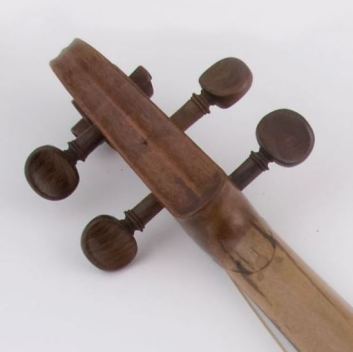
The new head/neck joint, complete with dowelling
Is the work up the Hills’ standard? Possibly not, so perhaps I am miles out. Perhaps it is simply that the work was done earlier to make it playable as a viola, say for someone to learn on. Why buy a viola when there’s already the old VDG in the house that can be shaved down a little? Or maybe the work was the best compromise after some serious damage. It is doubtful we will ever know.
So is this VDG a monster or is just a bit of Hollywood nip’n’tuck going on here? The neck surgery is quite apparent and the attachment of the head is anything but invisible, so it is fair to say that our old chap certainly could not go on Graham Norton and deny having had work done. Let’s be kind and say facelift rather than Frankenstein, but either way, unlike the rest of the half-dozen instruments on show in Old Tullie House, it looks like this old thing had to adapt the most to survive.
Andy
Curatorial Assistant
Name the Whale!
A £50,000 mission is being launched at the Museum to help exhibit our new fantastic whale skeleton. Don’t miss out on an opportunity to name the whale, and in so doing, help us to meet our target.
For those of you who might remember, in October last year I reported the discovery of a sei whale which the Museum was lucky enough to acquire (read here). The young whale was tragically stranded on a beach near Drigg, West Cumbria (2014) and was recovered by an expedition for the Museum some six months later. We received the first part of the whale in October, last year, (whilst the remainder is still underground decomposing with manure). Now, the whale patiently waits in an unused room, used for storage.
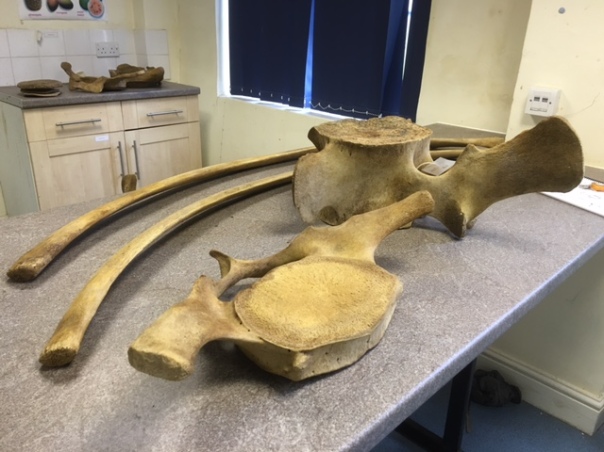
I visit whenever I can. It’s the highlight of my day. I am dwarfed by the vastness of the bones; ribs as long as me, vertebrae as big as small children and shoulder blades which look like giant hand fans. I’ve become somewhat immune from the stale stench of manure and tell myself that it is all in the aid of science. Today I am eagerly returning with a team of bright volunteers; Laura (Carter) and Conor (Cull) from the University of Cumbria; our mission is to select several of the bones for a small exhibition in the Atrium, as a taster for the full specimen when it will ultimately go on exhibit. But first things first, we can’t put these bones on exhibition until we remove some of that nasty manure!
Brushes and sponges at the ready; we go to washing the specimens, though it will be very delicately as I explain how fragile the specimens are. Christening the new box of blue latex gloves, with a distinct surgical look, we get the bones nice and wet to start with, with the sponge, which softens the dried manure. We then switch to brushes and the bristles are great for entrapping manure particles as they are swept gently over the bones.
However, I explain to Laura and Conor that the bones will still need expert cleaning by specialists in order to remove the fatty oils which now manifest themselves as an unsightly orange colour on the specimens. But here we should be relieved as the bones are not dripping with excessive amounts of fatty oils, which are common in fresh whale specimens. In a marine ecosystem, these oils would have provided food for communities of bacteria, mussels, and tube worms perhaps providing a feast lasting several decades. Many microbes depend on hydrogen sulphide and this gas is produced as the whale oil breaks down[1].
It seems that the action of the waves upon the specimen has naturally weathered them removing a lot of the oils, combined with their burial for a year with manure to aid decomposition (see previous blog). So all that work paid off!
The whale has an exciting future ahead, as I explain to my volunteers. After the oils have been removed, the specimen will then be put back together a bit like a jigsaw. I will work with external specialists in order to articulate the bones upon a frame. Although much of this work will be done in an off-site workshop, it is hoped that there will be some on-site construction where the whale is mounted in the Atrium.
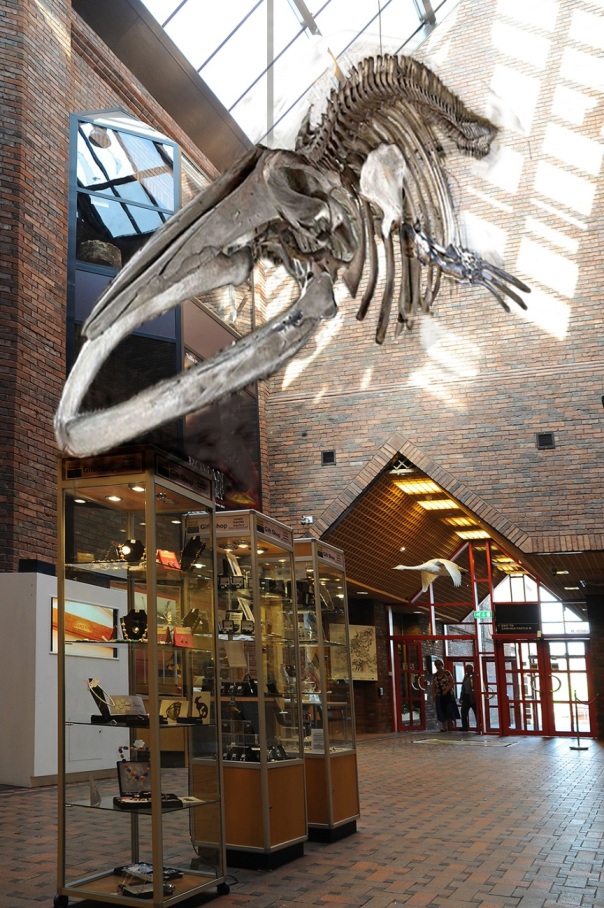
Visitors will be amazed as they look up as they enter the Atrium with a 14 m whale looking down at them. As the sun beams through the glass roof, in the summer, you will be “encaged” by the silhouette of the Leviathan. We hope that the whale will not only be a museum centrepiece, but will become a new icon for Carlisle. It would be our version of Dippy the Dinosaur from the Natural History Museum. Perhaps the train station might welcome visitors with “home of the whale”?
But as I said at the start this project, this will not come cheaply! We are currently estimating a ceiling cost of £50,000 which will cover travel, cleaning and modelling missing parts.
So how can you help? We are launching a series of public appeals: the first, Name the Whale, is where everyone can help. Choose your favourite name for the whale: it can be either male or female as we don’t know the sex of the specimen with any confidence. Please write your suggestion on the inside of the whale on the envelope (please donate £1 inside). Be inventive! Be creative! This is your chance to put your stamp on the newest addition to the Tullie family!
Stay tuned for our next blog post about the whale!
Simon Jackson
Curator of Natural Sciences
written Thursday, 25 February 2016
[1] http://planetearth.nerc.ac.uk/news/story.aspx?id=808&cookieConsent=A Marshall,T (2010) Oily Whale Bones Fuel Unique Ecosystems. Planet Earth Online (NERC Science of the Environment). (As accessed 26 February 2016)

